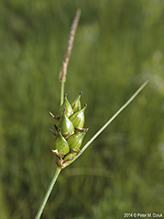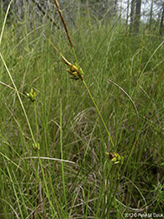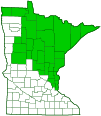few-seeded sedge
(Carex oligosperma)
Conservation • Wetland • Description • Habitat • Ecology • Use • Distribution • Taxonomy
Description |
||
Few-seeded sedge is a 14″ to 40″ tall, erect, perennial sedge that rises on a single stalk or in a loose clump with just a few stalks from a long, creeping, underground stalk (rhizome). It often forms loose colonies. The stem (culm) is slender, broadly three-angled in cross section, smooth, and tinged purple at the base. It is hairless but is sometimes rough to the touch on the angles near the tip. The leaves are wiry, stiff, dark green, hairless, and 1 ⁄32″ to ⅛″ wide. The margins are rolled inwards. The lower part of the leaf that surrounds the stem (sheath) of basal leaves is reddish-purple and usually persists into the next season. The appendage a the junction of the leaf sheath (ligule) is as wide or wider than long. The flowers appear from May to June. The inflorescence consists of 2 to 4 flower clusters (spikes) at the end of the culm. It is 1¼″ to 8″ long and is subtended by a single modified leaf (bract). The bract is stiff, straight, wiry, and usually 1¼″ to 6″ long, sometimes up to 10″ long. It is slightly shorter than or slightly exceeds the tip of the staminate spike. The spikes are unisexual, with all female (pistillate) or male (staminate) flowers. There are 1 to 3 lateral pistillate spikes and usually just a single terminal staminate spike. The lowest spike rises erect from the axil of the inflorescence bract. If there are one or two more pistillate spikes they are widely separated from the first and from each other. The staminate spike is held well above the uppermost pistillate spike. The pistillate spikes are erect and stalkless or nearly stalkless. They are short, plump, and egg-shaped to short-cylindric. They consist of just 3 to 15 inflated, ⅛″ to ¼″ long spikelets. The spikelet is a single flower surrounded by a sac-like structure (perigynium) and subtended by a modified bract (scale). The scale is egg-shaped, ⅛″to ¼″ long, and ⅛″ wide, shorter than the perigynium. It is sharply pointed but does not have a bristle-like extension (awn) at the tip. The perigynium is ascending, leathery, and shiny. It is inflated, egg shaped, ⅛″ to ¼″ long, and tapered at the tip. It ends in a 1 ⁄64″ to 1 ⁄32″ long, prolonged, terminal appendage (beak). There are 7 to 15 distinct, longitudinal veins that extend onto the beak. Enclosed by the perigynium is a single ovary with one style. The style is branched into three stigmas that project from the narrow opening at the top of the perigynium. Staminate spikes are slender, club-like, linear in outline, ascending to erect, and stalkless or short-stalked. They consist of many flowers in a dense, spiral arrangement. Staminate flowers have three stamens. The fruit is a dry, brown, one-seeded capsule (achene) with the three dried stigmas still attached. It is three-angled and 1 ⁄16″ to ⅛″ long, almost as large as the perigynium. It matures from June to July and persists on the plant into August or September. |
||
Height |
||
14″ to 40″ |
||
Similar Species |
||
Woolly-fruit sedge (Carex lasiocarpa) inside of leaf sheaths have distinctly raised cross lines (septations) between the veins. |
||
Habitat |
||
Wet. Bogs, fens, swamps, marshes, lakeshores, river banks. |
||
Ecology |
||
Maturing |
||
Mid-June to early September |
||
Pests and Diseases |
||
|
||
Use |
||
|
||
Distribution |
||||
|
Sources |
|||
| 4/16/2023 | ||||
Nativity |
||||
Native |
||||
Occurrence |
||||
Common in sphagnum bogs |
||||
Taxonomy |
|||
| Kingdom | Plantae (Plants) | ||
| Division | Tracheophyta (Vascular Plants) | ||
| Subdivision | Spermatophytina (Seed Plants) | ||
| Class | Liliopsida (Monocots) | ||
Order |
Poales (grasses, sedges, cattails, and allies) | ||
Family |
Cyperaceae (sedges) | ||
| Subfamily | Cyperoideae | ||
| Tribe | Cariceae | ||
Genus |
Carex (true sedges) | ||
| Subgenus | Carex | ||
| Section | Vesicariae | ||
Synonyms |
|||
Carex oligosperma var. churchilliana Carex oligosperma var. oligosperma |
|||
Common Names |
|||
bog wiregrass sedge few-fruited sedge few-seeded hop sedge few-seeded sedge fewseed sedge wiregrass |
|||
Glossary
Achene
A dry, one-chambered, single-seeded seed capsule, formed from a single carpel, with the seed attached to the membranous outer layer (wall) only by the seed stalk; the wall, formed entirely from the wall of the superior ovary, does not split open at maturity, but relies on decay or predation to release the contents.
Axil
The upper angle where a branch, stem, leaf stalk, or vein diverges.
Beak
A comparatively short and stout, narrow or prolonged tip on a thickened organ, as on some fruits and seeds.
Bract
Modified leaf at the base of a flower stalk, flower cluster, or inflorescence.
Culm
The hollow or pithy stem of a grass, sedge, or rush.
Ligule
In grasses and sedges, an outgrowth on the leaf at the junction of the blade and the sheath, usually membranous, sometimes no more than a fringe of hairs. In flowering plants, the ligule is the flat, strap-shaped, petal-like portion of the corolla of a ray floret.
Linear
Long, straight, and narrow, with more or less parallel sides, like a blade of grass
Perigynium
In Carex and other closely related sedges, a sac-like or flask-shaped, highly modified bract that surrounds the pistillate flower and later encloses the achene. Plural: perigynia.
Pistillate
Referring to a flower that has a female reproductive organ (pistil) but does not have male reproductive organs (stamens).
Rhizome
A horizontal, usually underground stem. It serves as a reproductive structure, producing roots below and shoots above at the nodes.
Scale
In plants: A small, usually flat and thin, modified leaf resembling the scale of a fish. In sedges: A dry, reduced bract at the base of the perianth. In animals: A small rigid plate growing out of an animal’s skin to provide protection. In butterflies and moths: A plate on the surface of the wing providing coloration.
Sheath
The lower part of the leaf that surrounds the stem.
Spike
The arrangement of an unbranched, elongated inflorescence with stalkless flowers that mature from the base toward the tip. In Cyperaceae, it also denotes a collection of one or a group of stalkless flowers, each subtended by scales, on a single inflorescence axis.
Spikelet
In flowering plants, a small spike. In grasses and sedges, the basic unit of inflorescence. In grasses, composed of usually two glumes and one or more florets. In sedges, a single flower and its single associated scale
Staminate
Referring to a flower that has a male reproductive organs (stamens) but does not have a female reproductive organ (pistil).
Visitor Photos |
|||||
Share your photo of this plant. |
|||||
| This button not working for you? Simply email us at info@MinnesotaSeasons.com. Attach one or more photos and, if you like, a caption. |
|||||
Katy Chayka |
|||||
 |
 |
||||
MinnesotaSeasons.com Photos |
|||||
|
|||||

Slideshows |
||

Visitor Videos |
|||
Share your video of this plant. |
|||
| This button not working for you? Simply email us at info@MinnesotaSeasons.com. Attach a video, a YouTube link, or a cloud storage link. |
|||
Other Videos |
|||
| Carex oligosperma Timothy M. Jones |
|||
About
Uploaded on Aug 26, 2007 Carex oligosperma habit and dissection |
|||

|
Created: Last Updated: © MinnesotaSeasons.com. All rights reserved. |


